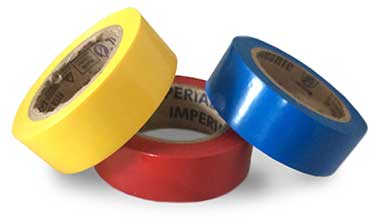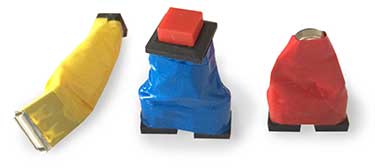Saving and Security
This kit is not certified, since it was not manufactured. Depending on how it was produced, it may contain small parts that are dangerous to younger children.
The age rating is given only by institutes that certify commercial products, but as a reference, similar kits are indicated to ages 8 and older.
How to save money
RUTE doesn’t have a pattern in connectors. Despite we always use the same kind in examples; we also explain how to use different kinds of connectors. This may be understood as a negative characteristic, because a kit produced someone might not be compatible with another one made by others.
But we conscientiously made this choice, prioritizing cost and easiness. In a country or region might be easier to find scrap or stores that sells telephony cables (connector RJ11), while in others might be easier to find network connectors (RJ45).
For it’s simple (and cheap) to produce, a kit might be unset and repurposed in case it needs to change the connector pattern.
Choose wisely which connector to use
Connectors are the most used parts to assemble the kit. See on the image below, to connect energy units, button and LED will be necessary 9 connectors (4 males and 5 females). The difference between a cheap connector and an expensive one can easily double the costs.
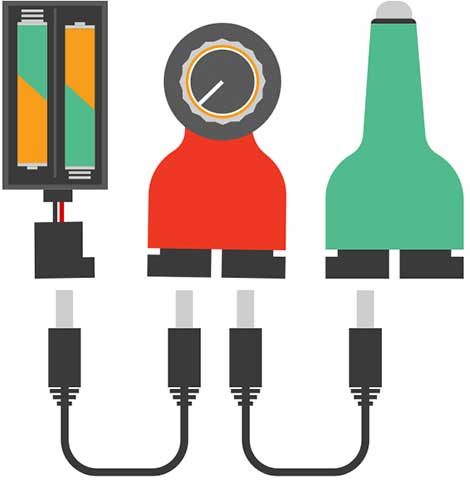
Buy in big quantity
Resistors are a good example. A pack with 100 of them costs around US$ 1.00 (or US$ 0.01 each), but they are so cheap that buying a 10 pack would cost the same US$ 1.00.
Connectors can also have big discounts when bought in high quantities. In our experience, in stores, buying in big packs can reduce from 20% to 50% in the product value.
Arrange with your friends to buy and assemble your kits together. It would be more fun, more profitable and will cost less. Buying 100 unities of connectors would last to assemble 5 or more basic kits.
Buy used
If you don’t have access to scrap but want to save, look up in your town, there are stores that sell’s used parts in great conditions, recovered from scrap or stores stocks that haven’t sold well.
For example, São Paulo (Brazil) has stores that sell vibration motors (and other components) in perfect conditions for US$ 0.30. A new one costs from US$ 2 to US$ 4
Buy online
Websites likes AliExpress and eBay has thousands of suppliers with good prices and free shipping. In some countries (like Brazil) deliver could take months, but the price usually pays off. Look for suppliers with large quantities and great reviews.
Don’t buy tools, borrow them
With all the parts in hand, you’ll take only a few hours to assemble a kit. If you have no experience at all, maybe a little longer. But even so, it’s not enough time to justify the acquisition of tools of your own. Despite of being cheap, tools like soldering iron and pliers are very resistant and most of the owners wouldn’t mind lending you for one or two days.
Use Ethernet cable (network)
Used electric cables are very easy to find, but if you want to buy them new, you’ll be expending around US$ 0.30 per meter. If you want the double cable (with two wires connected) it would cost around US$ 0.60. No economy on that, just the convenience of the cables coming already stuck together. But of you use Ethernet cables you’ll pay US$ 0.40 and it would come with 8 cables. They’re rigid cables. It isn’t better nor worse, maybe you’ll find it even easier to solder. But the point is that at this price, you’ll be paying US$ 0.05 per meter of cable.
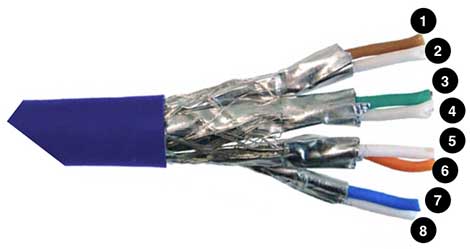
Use Scrap
Using scrap can reduce the kit’s cost up to 70%.
Some components like motors and fans can be expensive if bought new, but you can find them in old toys and electronic equipment. Another good example are the connectors, the telephony and the network cables.
A good place to start digging is places where they fix computers and printers. One’s trash is other’s treasure ; D
Tips about scrap
The voltage that we use is 5V, which means that a part with a smaller voltage might fry. A traditional LED is 3V. That’s why we use a resistor to power a LED.
Using components that requires a higher voltage, like a 12V fan, most of times will work, but really slow. The motor will work a lot slower and the wind it generates would be very weak. Another example: A LED ribbon which is 12V wouldn’t even light up with only 5V.
DO NOT disassemble TV sets, microwave ovens, generators, no-breaks, motors and industrial equipment. If you do not understand anything of electronic, a basic safe rule might be: If it’s powered on the electrical network (AC 127V or 240V), do not open. Some of these equipment can cause electric shocks even if it’s not plugged on the outlet. For that you should prefer small electronic equipment, powered on batteries.
Worry about safety.
Make sure the solder stuck well so the kit won’t lose small parts or brake easy. Use hot glue (or electrical tape) in the loose-wired components so if someone pulls the wire the pressure won’t be done in the solder point and if someone presses the kit, a wire won’t touch another, what could cause a short circuit.
This image demonstrates the use of hot glue to prevent the two component’s pins to touch one another. And between components that have loose wires, like motors, also use hot glue in the contact points to get everything more resistant.
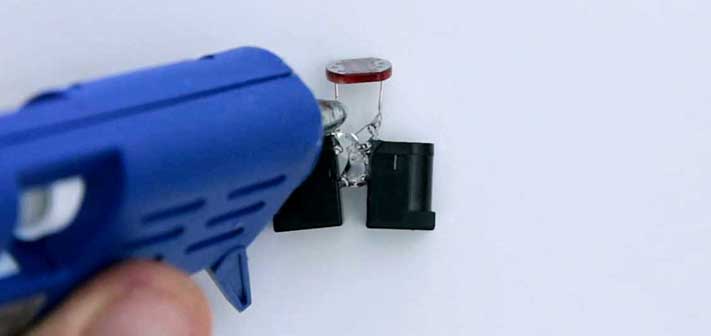
Use safety glasses to produce the kit
You might think this is unworthy or that we’re saying it for legal reasons, but the glasses are really important. When using the cutting pliers is very likely that small pieces of metal will fly off at high speeds, which may cause severe damage to the eye.
Do not leave sharp corners or edges
This product will be hand used. Even though it will be used only under supervision of an adult, to plug cables people use to make pressure. For this reason, do not leave edges that might pierce finger.
Finish is important
Kit’s finish is imp0ortant to generate attractiveness. The cheaper option is to use electrical tape, but we recommend the use of heat-shrink tube. It’s a hollow cable sold in different widths and colors. It works as an electric insulate and its application is very easy because it shrinks to half its original width when heat is applied.

DeThis way, it sticks pretty well in the components. To apply heat, you can use the professional solution (heat gun) or the homemade (hairdryer). Our recommendation is to use three colors of tubes. Use black on the energy module and two others. One for inputs (buttons, intensity etc.) and another to outputs (motors, lights, buzzers etc.)
It’s also possible to use color electrical tapes. It’s a cheaper option, but not as presentable.
